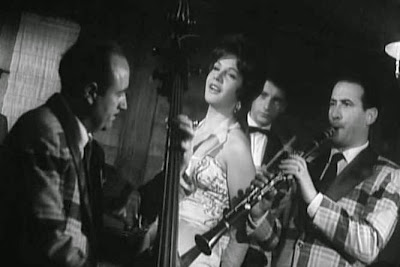 |
| Ana Castor invents the Batusi in Jess Franco's LABIOS ROJOS. |
The DVD is presented solely in Spanish, with no subtitle option, so I could only follow the most obvious dialogue, but the performances are lively and comic with the two female leads, Isana Medel and Ana Castor (supposedly Franco's fiancée at the time, though they never married), fairly well in key with the ditzy characters portrayed by Rosanna Yanni and Janine Reynaud in 1967's KISS ME MONSTER and TWO UNDERCOVER ANGELS. The film is shot almost like a parody of an Orson Welles movie, with lots of Dutch angles and grotesque distortions and stylized shots of gun play in wharf shacks and jazz bands in nightclubs.
The film has an inconsistent look, containing second unit shots, various inserts and two or three scenes that were shot open aperture in contrast to the hard-matted 1.66:1 framing of majority of the picture. Carlos Aguilar's book on Franco mentions that the production ran out of money and was abandoned by its crew in protest before filming was completed. Two cinematographers are credited - Emilio Foriscot and Juan Mariné, both of whom enjoyed long and busy careers. According to to Franco authority Francesco Cesari, the film commenced production with Mariné, with whom Franco also made a couple of shorts around this time, but he had to leave when an opportunity for paying work arose. He was then replaced by Foriscot - whose later work would include such highlights as the Kriminal films, LA MARCA DEL HOMBRE LOBO with Paul Naschy, and Sergio Martino's BLADE OF THE RIPPER - who shot the majority of the film. If everyone abandoned the production at some point, it is possible that Franco himself took over to shoot the open aperture material, because this work doesn't show the same facility with lighting as the other footage. The most substantial full aperture content includes a scene of Kallman and his henchmen giving Mari a lift home in his car, and the exterior portions of a climactic shoot-out, scenes that incorporate dialogue but was shot either out-of-doors or in a car, so that none of it required the building of a set. The jazz bits aside, the non-diegetic score is much too frenzied and melodramatic - it often reminded of Roman Vlad's barnstorming score for Freda's I VAMPIRI.
LABIOS ROJOS is not quite steady on its feet but it's a likeable companion piece to Franco's first picture, TENEMOS 18 ANOS (1959) and obviously the work of the same man who made the far more confident THE AWFUL DR. ORLOF, THE SADISTIC BARON VON KLAUS and THE DIABOLICAL DR. Z.
As far as quality goes, just be glad it's available at all. The source material has the general appearance of a 16mm print. The transfer and mastering are barely acceptable, with neither clean-up nor anamorphic enhancement. Scenes with heavy blacks tend to digitize and break up, and the 1.66:1 matte box edges are exposed, leaving unevenly rounded corners and other distractions. I have cropped the frame grabs below to make a better impression.
Just as surprising as the sudden availability of the main feature is the disc's only extra, EL TREN EXPRESO ("The Express Train"), a heretofore unknown short (running just under 10m) produced by Franco's company Golden Films International and directed by Rosa Maria Almirall - the real name of actress Lina Romay. Based on the poem by Ramon Campoamor, which is read aloud by "Laura Arias" (Romay herself), it uses children's book and travel book illustrations to forge a charming valentine to the bygone days of the luxury railcar. It is completely unlike anything else we've ever seen from Lina Romay.
Where can you find it? Try here.








